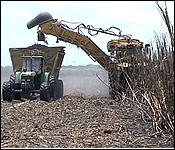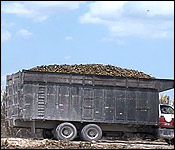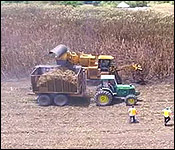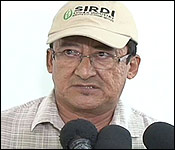

 Belize's sugar cane industry is one of the bedrocks of the Belizean economy, but, experts agree, it won't remain competitive much longer if farmers don't modernize. Presently, the old way of cane cutting with a machete is still the way cane is harvested, but now, ASR-BSI is trying to prod farmers towards mechanization. Daniel Ortiz found out more when he went North TO SAN ESTEVAN, Orange Walk today:...
Belize's sugar cane industry is one of the bedrocks of the Belizean economy, but, experts agree, it won't remain competitive much longer if farmers don't modernize. Presently, the old way of cane cutting with a machete is still the way cane is harvested, but now, ASR-BSI is trying to prod farmers towards mechanization. Daniel Ortiz found out more when he went North TO SAN ESTEVAN, Orange Walk today:...
Daniel Ortiz reporting
Mechanized Harvesting, it's a concept that's been floating around in the Sugar belt for a few years now, but for this crop season, BSI/ASR has actually been putting it into practice. There was initial resistance from the thousands of cane farmers who are used to hiring laborers to harvest their cane manually. But, they're slowly warming up to the idea, and for these last few months, 37 of them signed up to be part of a pilot project run by the millers to test out mechanical harvesting for themselves.
And what they have found is that BSI wasn't offering empty promises. This way of harvesting is more efficient and more cost effective.
Each these mechanized harvesters are able to cut 38 tons of cane per hour. Every time you see one of these high dumping wagons fill up, that's about 6 to 7 tons of cane being offloaded to a truck, which can be taken to the mill for grinding.
For this pilot project, BSI will oversee the harvesting of 28,681 tonnes of cane from these 37 growers.
 Enrique Rivas - Field Agronomist, ASR/BSI
Enrique Rivas - Field Agronomist, ASR/BSI
"This year we have already gotten 37 farmers that have signed with us, contracts with this mechanical harvesting pilot project. We have approximately 1,300 acres into the project. More or less, it is 35,000 tons that is being amalgamated. The benefit is to reduce cost. The industry as a whole is looking forward to reducing cost. What we want to do is maximize our profits."
And to qualify, each of these 37 farmers had to submit their cane fields to rigorous testing. The 250 fields that will be mechanically harvested were carefully selected for quality. They had to have the right level of flatness, free of debris like rocks and stumps that could damage the harvester's blades, and each row of cane had to be carefully measured out so that the harvester can properly pass over them and catch every stalk of mature cane.
Enrique Rivas - Field Agronomist, ASR/BSI
"We go about doing site visits. We have to visit all the cane fields that they are talking about, ensuring that the fields are at least harvester friendly."
But each and every one of the farms will be rewarded for their diligence. They will cut the cost of their harvest by $6.38 per ton of cane. That might not sound like much but, this project will see allow all 37 farmers to reap a total savings of 205,000 dollars.
That by itself justifies mechanized harvesting, but it has additional benefits. For one, harvested cane goes to the mill with less debris. Muddy cane has caused grinding to fall behind schedule due to the problems it brings. Mechanized harvesting cuts that down, and it also reduces the amount of cane lost during the harvesting phase.
So, that's a win all around.
Enrique Rivas - Field Agronomist, ASR/BSI
"Farmers will start realizing little by little that it is for the benefit of their families that we need to move into mechanical harvesting."
But, the harvesters burn a lot of fuel, and so, the project coordinators must make sure that they can efficiently use the machines so that the cost effectiveness endures.
Enrique Rivas - Field Agronomist, ASR/BSI
"What we have for fuel consumption is 1.2 liters per ton. We want to spend less or equal to 1.2. So if we can do less than 1.2, it is more efficient. That means you're spending less fuel for cutting that same ton of cane."
One cane farmer told us that he had to take a long look at the viability of his way of life, and that's why he tried out mechanized harvesting.
 Cane Farmer
Cane Farmer
"Last year's price on the sugar definitely was not conducive for me as a cane farmer. If I continued paying the amount of price I was paying just for harvesting and delivery - the mechanical harvesting cuts my costs almost 20%. So if you are presently committed to any financial institution and the price of sugar comes at 50-52 dollars per ton, automatically you are out of business in 2-3 years. So things like that make farmers make drastic changes. Of course I was concerned, I was wondering in my cane fields are ready. If we do not make changes right now under the circumstances, a lot of us will be out of business, a lot."
So, with this crop cycle, less than 5% have tried it out for themselves. BSI is hoping that it will soon become the industry standard, but they accept that they can't get to a state of fully mechanized harvesting
Enrique Rivas - Field Agronomist, ASR/BSI
"It is not very likely 100%. Why? Because there are certain fields that are very rocky, so there is no way that you would be able to harvest cane with a harvester on those fields. Our way is paving at least 70-80% of the cane and if we can attained 90%, then it would be just much finer."
 Ernesto Pop - Farmer Relations, Field Officer, ASR/BSI
Ernesto Pop - Farmer Relations, Field Officer, ASR/BSI
"It's something new and we have to walk farmers through the project. We give them the benefits of it."
But, it's a move that the experts believe will help to keep Belize's industry viable.
 William Neal - Communications & Government Affairs Officer, ASR/BSI
William Neal - Communications & Government Affairs Officer, ASR/BSI
"This pilot project is indicative of the type of changes that the industry must make, in terms of trying to remain viable and competitive. We are a small country and the world market prices are set by larger countries like Brazil. If you want to compete, you have to see whether its $6 here or there. You have to see exactly where you can save a penny and it means in some cases that you have to move away from the way you always done it and having a romanticize kind of notion that this is the best that we can do to actually compete with everybody. Post Brexit and as the EU regime changes, we as an industry we have to come together and see what are the best ways that we can pool all our resources to make sure that we remain competitive, not only for this region, but globally as well."
| 
